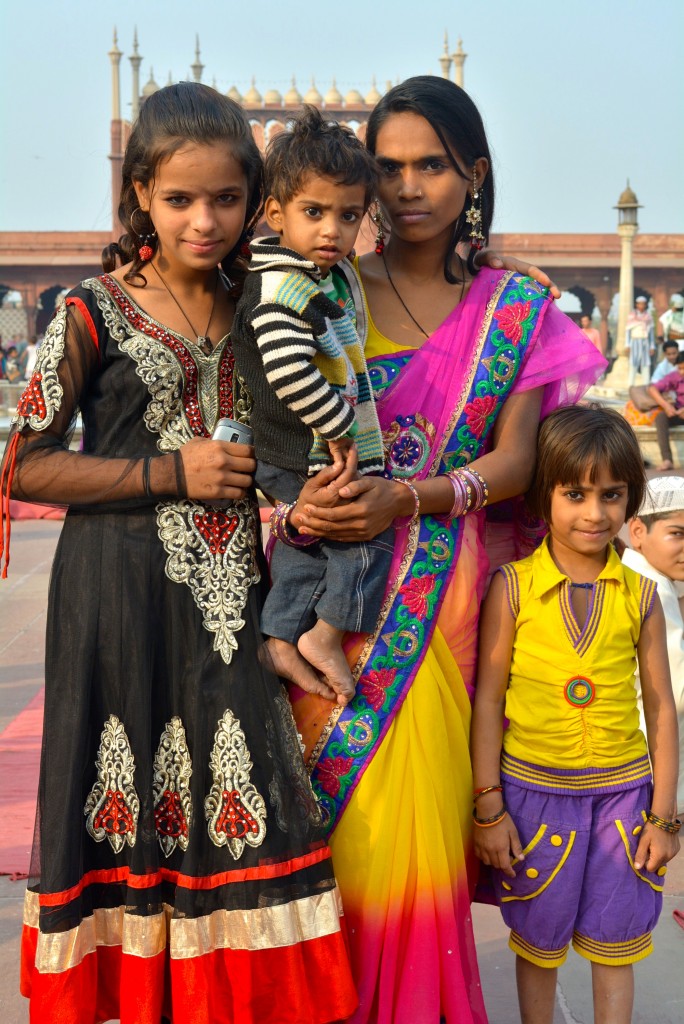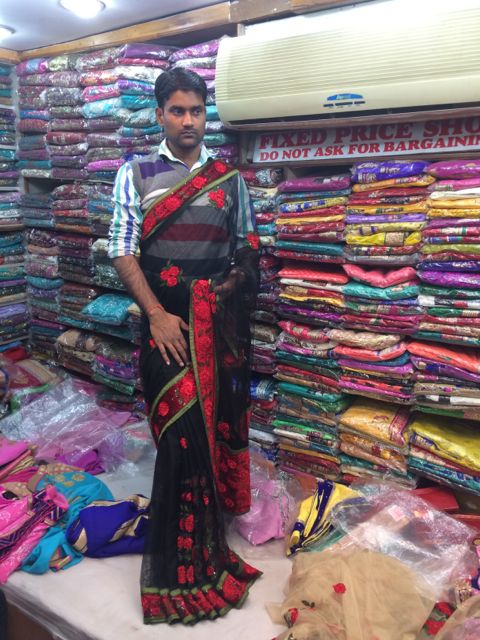Upon going to India, I was not nearly prepared enough for the bombardment of smells, spices, colors and culture that struck me as being so different from any of the ones I had ever seen in the United States. One of the main differences that caught my eye and immediately piqued my curiosity was the Indian sari. The sari, which can be spelled sari, saree, or shari, is a common garment worn by women in south Asia. The term itself is derived from the Sanskrit language and its meaning translates to ‘strips of cloth’. This form of clothing has been worn for thousands of years in this region and can be seen depicted in various historical texts, art, and holy writings. The sari is commonly worn by women in India, Bangladesh, and Sri Lanka as a symbol of grace, beauty, and cultural pride.
 On our recent trip to India with Go Eat Give, we were lucky enough to have the opportunity to visit a sari shop in Chandigarh. There, we learned quite a bit about the styles and ways in which saris are worn, in addition to the many different kinds of fabric and pattern. Upon entering the shop, we were surprised to see wall to wall saris stacked to the ceiling. The shop owners, although male, demonstrated how to tie a sari, and the different articles of clothing that you need in order to wear a sari properly.
On our recent trip to India with Go Eat Give, we were lucky enough to have the opportunity to visit a sari shop in Chandigarh. There, we learned quite a bit about the styles and ways in which saris are worn, in addition to the many different kinds of fabric and pattern. Upon entering the shop, we were surprised to see wall to wall saris stacked to the ceiling. The shop owners, although male, demonstrated how to tie a sari, and the different articles of clothing that you need in order to wear a sari properly.
The typical sari seen on the streets of India and southern Asia is about 5-9 yards in length with a width of at least 2-4 feet. The fabric is usually cotton, chiffon or silk in most cases, but varies from region to region. It is draped across one shoulder, sometimes revealing part of the torso. The reason why the navel or midriff is left bare in many sari styles is due to the belief that this is the location from which comes life and creativity. This area is to be left uncovered in order to pay homage to this belief.
When visiting India or your local sari shop, you can see sarees in every fabric, color, style and shape. Most saris are detailed with incredibly intricate patterns or embroidery. Being a student of design, I quickly became obsessed with the trends and styles of these beautiful cultural gowns. I came to notice that not only are there countless ways to wear these traditional outfits, but that the design varied according to the region, climate, and state.
In addition to giving it unique style, the coloring of saris also holds meaning. Red saris are typically seen during Indian weddings, for the color red is thought to bring good luck to the bride and to her marriage. Orange is also a color you see frequently because it signifies luck, and is representative of saffron, a commonly used spice in India. Green overtones are symbolic for festivity and celebration. Below, you can see an example of the numerous colors of saris as well as a model of how they are worn.

An assortment of sarees, cholis, and other traditional Indian dresswear displayed at a storefront on the streets of Chandigarh, India.
While there are countless variations of how to wear a sari, there are a few styles that are commonly seen, such as Uttariya, which is the part of the wrap that covers the upper body and many times the head. The typical sari is made up of a large piece of cloth and a blouse and petticoat, which must be tailored. The fabric that goes over the petticoat and blouse is versatile and is made to fit most sizes. Another common style is the Kerala mundum neryathum, which is a traditional two-piece sari. The one-piece sari is typically seen as a more modern invention that borrows from western culture.
The blouse that is worn under the sari or shawl on the other hand is called a choli. The common choli is short and somewhat tight fitted, revealing the midsection. Historically, cholis used to only cover the front of the body and leave the back open. This was as much due to India and south Asia’s hot climate as well as past stylistic preferences. This particular kind of backless sari can still be seen in parts of the state of Rajasthan today.
As for sarees that are worn for special occasions, the wedding sari remains not only the most interesting but also the most popular. A traditional Indian wedding sari is red in color and made of the finest silk. It is complimented by ornate amounts of jewelry, such as bangles, necklaces, nose rings, rings, and exquisite gems and jewels that are designed or hand-sewn into the sari itself. Indian wedding saris are typically very expensive and ornamental due to the fact that Indian weddings are some of the biggest events thrown in India, if not in the world. The typical Indian wedding can easily consist of over a thousand guests and a designer wedding sari can set you back a few thousand dollars.
An Indian wedding is a much bigger deal than it is in the United States because Indian culture believes that a wedding between two people is more than just a legally-binding affair. It is a sacred bond that must be honored, respected, and blessed by the Gods in order to bring both families honor, peace, and happiness. It is partially due to these beliefs that typical Indian weddings run so large, and also why the bride’s sari is the most ornamented and elaborate of them all.
I have to admit that at the end of the day, one of my favorite experiences of India was having the opportunity to see and study saris and the way they are worn. They are a beautiful representation of Indian tradition and it was refreshing to see so many women walking around with such a beautiful display of their culture. The Indian saris were so stunning, that every member of our Go Eat Give group bought at least one – myself included!
